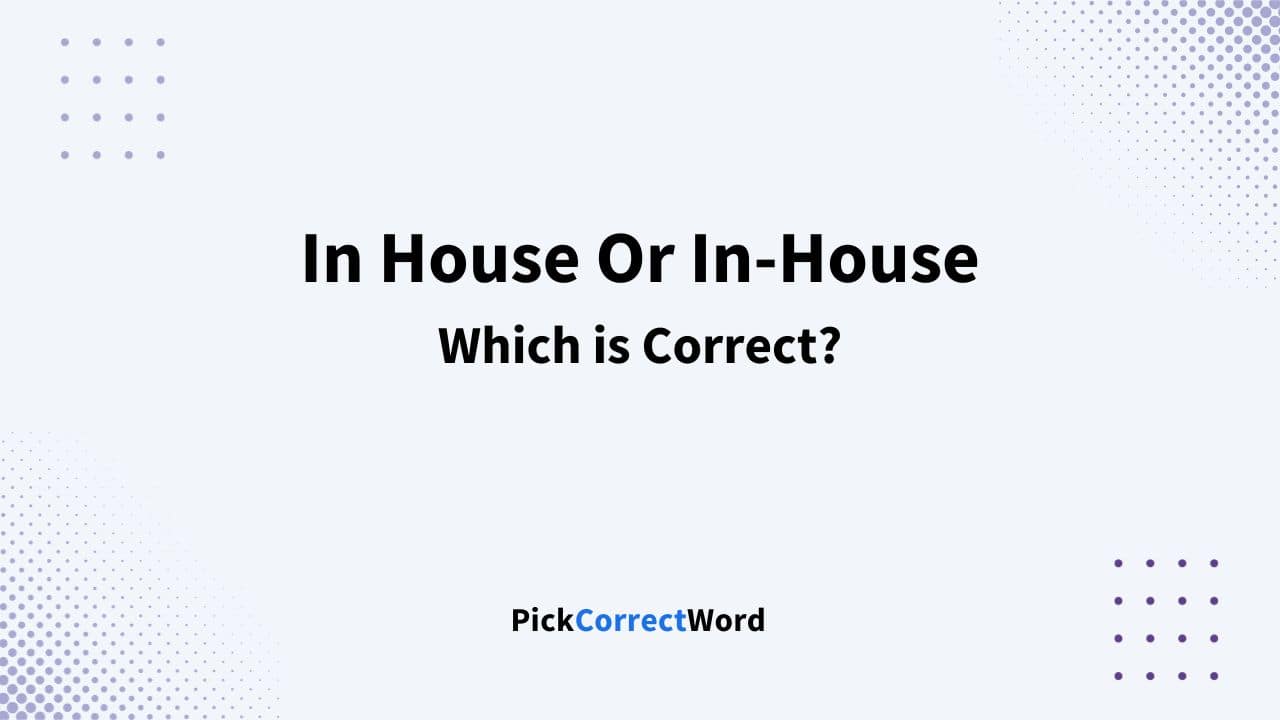This hyphenated version “in-house” is grammatically correct as an adjective or adverb, referring to activities or services performed within a company. Using “inhouse” or “in house” is incorrect in written English
“In-house” is the right word to use when you’re talking about tasks or services done inside your company, instead of getting someone outside to do it.
“In-house” means that your company has the ability or services needed right there in your workplace. This could be teams that make products, handle projects, or give training
Inhouse or In-House or In House? Which is Correct?
When you’re choosing between “inhouse”, “in-house”, and “in house”, remember to always use “in-house”.
Only “in-house”, with a hyphen, is the right way to write it when you’re using it as an adjective or adverb. Let’s understand why this is the right choice and how you can use it correctly.
Is “in-house” the correct version compared to “in house”?
Yes, “In-house”, with a hyphen, is the correct one. The hyphen ties ‘in’ and ‘house’ together to show that something is done inside a company by its own team or resources.
Is it “inhouse” or “in house”? Is it one word or two?
Actually, both are wrong. When you’re talking about things happening inside a company, it’s always two words with a hyphen: “in-house”.
Grammatical Basis for saying “In-House“
When you put two or more words together to form an adjective in front of a noun, make sure to connect them with a hyphen. This will help clear up any confusion and show that these words are working together as single concept.
The hyphen in “in-house” ties the words ‘in’ and ‘house’ together to describe something that’s done within your company. Using “in-house” with a hyphen makes the meaning instantly clear and avoids any mix-ups.
Examples:
- In-house training programs are developed by the company’s staff for its employees.
- Our in-house legal team consists of lawyers who are employed directly by the corporation.
Other Correct Ways of Saying: “In House”
When you’re talking about something done inside a company, using “in house” without a hyphen isn’t correct.
However, there can be situations where “in” and “house” are not working together to describe something, and then it’s okay to use them separately.
Why ‘in the house’ is a better version than ‘in house’
If you want to use ‘in house’ as two separate words correctly, you’ve got to add ‘the’ in the middle. This links the word ‘in’ to the word ‘house’.
Also, putting ‘the’ before ‘house’ makes things clearer and more specific. It shows that the work or activity is happening right there in your company and being done by your own team.
Examples of using ‘In-house’ in a sentence:
“Your firm benefits from having an in-house legal team.“
“They offer in-house training for all new employees.“
“The software was developed by their in-house programmers.“
“You can save costs by using in-house resources.“
“She prefers to work with the in-house designers for her projects.“
“In-house production ensures better quality control.“
“To address this issue, please contact our in-house support staff.“
“The company’s in-house catering services are exceptional.“
“Maintaining an in-house IT department can be advantageous.“
“Their in-house research led to a groundbreaking discovery.“
Frequently Asked Questions
Is “infront” the correct spelling in English?
No, “infront” is not recognized as a correct spelling. The correct form is two separate words: “in front.”
When is it appropriate to use “in front”?
The term “in front” is used to indicate a position ahead or before something or someone. For example, “Please wait in front of the building.”
How can I remember the correct form to use?
Remember that “in” and “front” are two separate words, and like other prepositional phrases, a space is always required between them.


